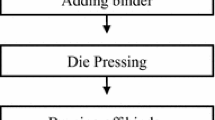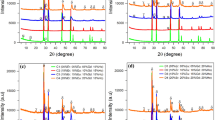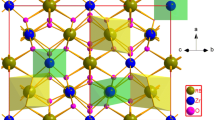Abstract
To examine the effect of doping/co-doping on high-temperature phase compositions of YSZ, stand-alone YSZ and CeO2 and Nb2O5 co-doped YSZ samples were prepared using mechanical alloy and high-temperature sintering. XRD analysis was performed on these samples from room temperature to 1100 °C. The results show that the structure for the co-doped samples tends to be thermally stable when the test temperature is higher than a critical value. Monoclinic phase was dominant in Nb2O5 co-doped YSZ at temperatures lower than 600 °C, while for the YSZ and CeO2 co-doped YSZ, cubic/tetragonal phase was dominant in the whole test temperature range. The lattice parameters for all the samples increase with increasing test temperature generally. The lattice parameters for the two non-trivalent rare earth oxides co-doped YSZ show that the lattice parameter a for the cubic phase of the Ce4+ co-doped YSZ is consistently greater than that of 7YSZ which is related to the presence of larger radius of Ce4+ in the matrix. The lattice parameters a, b, c for the monoclinic phase of Ce4+ co-doped YSZ are much closer to each other than that of the Nb5+ co-doped YSZ, indicating the former has better tendency to form cubic/tetragonal phase, which is desired for vast engineering applications.









Similar content being viewed by others
References
A. Mensch and K.A. Thole, Overall Effectiveness of a Blade Endwall With Jet Impingement and Film Cooling, J. Eng. Gas Turbines Power-Trans ASME, 2014, 136(3), p 031901
S.L. Jiang, X. Huang, and Z. He, Phase Transformation and Lattice Parameter Changes of Trivalent Rare Earth Doped YSZ as a Function of Temperature, J. Mater. Eng. Perform., 2016, 25(11), p 4686–4694
A.H. Heuer (ed) Review: Phase Transformations and Microstructural Characterization of Alloys in the System Y2O3-ZrO2, in Advances in Ceramics. ed. a.H.Y. N.Y. S Somiya, WesterviUe. 1988. P. 3–20.
T.K. Gupta, J.H. Bechtold, and R.C. Kuznicki, Stabilization of Tetragonal Phase in Polycrystalline Zirconia, Journal of Material Science, 1977, 12, p 2421
V. Kumar and B. Kandasubramanian, Processing and Design Methodologies for Advanced and Novel Thermal Barrier Coatings for Engineering Applications, Particuology, 2016, 27, p 1–28
M. Janus et al., Plasma Assisted Chemical Vapour Deposition—Technological Design of Functional Coatings, Arch. Metall. Mater., 2015, 60(2), p 909–914
L. Guo, M. Li, and F. Ye, Phase Stability and Thermal Conductivity of RE2O3 (RE = La, Nd, Gd, Yb) and Yb2O3 Co-doped Y2O3 Stabilized ZrO2 Ceramics, Ceram. Int., 2016, 42(6), p 7360–7365
H. Siethoff, A single Law for the Activation Energies of Self-diffusion of Various Cubic Metals, Intermetallic Compounds, Ionic Crystals and Oxides, Phys. Status Solidi B-Basic Solid State Phys., 2007, 244(4), p 1296–1303
I.R. Gibson, G.P. Dransfield, and J.T.S. Irvine, Sinterability of Commercial 8 mol% Yttria-Stabilized Zirconia Powders and the Effect of Sintered Density on the Ionic Conductivity, J. Mater. Sci., 1998, 33(17), p 4297–4305
Material Data Inc, MDI Jade 6 User’s Manual. 2004.
D. Gosset and M. Le Saux, In-Situ X-ray Diffraction Analysis of Zirconia Layer Formed on Zirconium Alloys Oxidized at High Temperature, J. Nucl. Mater., 2015, 458, p 245–252
H.G. Scott, Phase Relationship in Zirconia-Yttria System, J. Mater. Sci., 1975, 10(9), p 1527–1535
W. Wang, S.Q. Qian, and H. Shen, Microstructure and Mechanical Properties of Yttria-Stabilized Zirconia Coatings Produced by Eletrophoretic Deposition and Microwave Sintering, Metall. Mater. Trans. A-Phys. Metall. Mater. Sci., 2011, 42A(11), p 3265–3268
A. Kuwabara et al., Influence of Interaction Between Neighboring Oxygen Ions on Phase Stability in Cubic Zirconia, J. Am. Ceram. Soc., 2002, 85(10), p 2557–2561
P. Kountouros and G. Petzow, Defect chemistry, phase stability and properties of zirconia polycrystals, Science and Technology of Zirconia, V.S. Badwal, M. Bannister, and R. Hannink, Ed., Technomic, Lancaster, Basel, 1993, p 30–48
A. Dwivedi and A.N. Cormack, A Computer-Simulation Study of the Defect Structure of Calcia-Stabilized Zirconia, Philos. Mag. A-Phys. Condens. Matter Struct. Defects Mech. Prop., 1990, 61(1), p 1–22
V.I. Aleksandrov et al., Synthesis and crystal growth of refractory materials by RF melting in a cold container, Current Topics in Materials Science, North-Holland Pub. Co.; Elsevier North-Holland, Amsetrdam, 1978, p 4210–4480
J.H. Zhang et al., Thermal Expansion and Solubility Limits of Cerium-Doped Lanthanum Zirconates, J. Alloy. Compds, 2012, 525, p 78–81
Author information
Authors and Affiliations
Corresponding author
Rights and permissions
About this article
Cite this article
Jiang, S., Huang, X., He, Z. et al. Phase Transformation and Lattice Parameter Changes of Non-trivalent Rare Earth-Doped YSZ as a Function of Temperature. J. of Materi Eng and Perform 27, 2263–2270 (2018). https://doi.org/10.1007/s11665-018-3159-3
Received:
Revised:
Published:
Issue Date:
DOI: https://doi.org/10.1007/s11665-018-3159-3




